Sicheng Mo
SimGen: Simulator-conditioned Driving Scene Generation
Jun 13, 2024
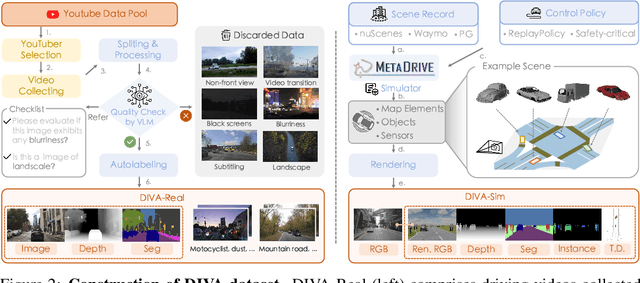
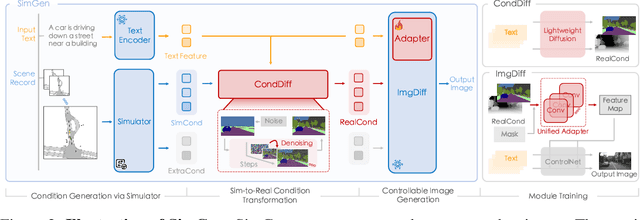

Abstract:Controllable synthetic data generation can substantially lower the annotation cost of training data in autonomous driving research and development. Prior works use diffusion models to generate driving images conditioned on the 3D object layout. However, those models are trained on small-scale datasets like nuScenes, which lack appearance and layout diversity. Moreover, the trained models can only generate images based on the real-world layout data from the validation set of the same dataset, where overfitting might happen. In this work, we introduce a simulator-conditioned scene generation framework called SimGen that can learn to generate diverse driving scenes by mixing data from the simulator and the real world. It uses a novel cascade diffusion pipeline to address challenging sim-to-real gaps and multi-condition conflicts. A driving video dataset DIVA is collected to enhance the generative diversity of SimGen, which contains over 147.5 hours of real-world driving videos from 73 locations worldwide and simulated driving data from the MetaDrive simulator. SimGen achieves superior generation quality and diversity while preserving controllability based on the text prompt and the layout pulled from a simulator. We further demonstrate the improvements brought by SimGen for synthetic data augmentation on the BEV detection and segmentation task and showcase its capability in safety-critical data generation. Code, data, and models will be made available.
Ctrl-X: Controlling Structure and Appearance for Text-To-Image Generation Without Guidance
Jun 11, 2024Abstract:Recent controllable generation approaches such as FreeControl and Diffusion Self-guidance bring fine-grained spatial and appearance control to text-to-image (T2I) diffusion models without training auxiliary modules. However, these methods optimize the latent embedding for each type of score function with longer diffusion steps, making the generation process time-consuming and limiting their flexibility and use. This work presents Ctrl-X, a simple framework for T2I diffusion controlling structure and appearance without additional training or guidance. Ctrl-X designs feed-forward structure control to enable the structure alignment with a structure image and semantic-aware appearance transfer to facilitate the appearance transfer from a user-input image. Extensive qualitative and quantitative experiments illustrate the superior performance of Ctrl-X on various condition inputs and model checkpoints. In particular, Ctrl-X supports novel structure and appearance control with arbitrary condition images of any modality, exhibits superior image quality and appearance transfer compared to existing works, and provides instant plug-and-play functionality to any T2I and text-to-video (T2V) diffusion model. See our project page for an overview of the results: https://genforce.github.io/ctrl-x
SnAG: Scalable and Accurate Video Grounding
Apr 05, 2024Abstract:Temporal grounding of text descriptions in videos is a central problem in vision-language learning and video understanding. Existing methods often prioritize accuracy over scalability -- they have been optimized for grounding only a few text queries within short videos, and fail to scale up to long videos with hundreds of queries. In this paper, we study the effect of cross-modal fusion on the scalability of video grounding models. Our analysis establishes late fusion as a more cost-effective fusion scheme for long-form videos with many text queries. Moreover, it leads us to a novel, video-centric sampling scheme for efficient training. Based on these findings, we present SnAG, a simple baseline for scalable and accurate video grounding. Without bells and whistles, SnAG is 43% more accurate and 1.5x faster than CONE, a state of the art for long-form video grounding on the challenging MAD dataset, while achieving highly competitive results on short videos.
FreeControl: Training-Free Spatial Control of Any Text-to-Image Diffusion Model with Any Condition
Dec 12, 2023
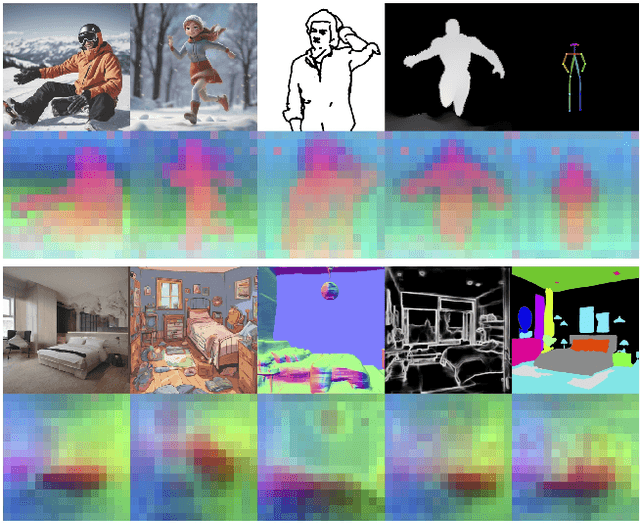
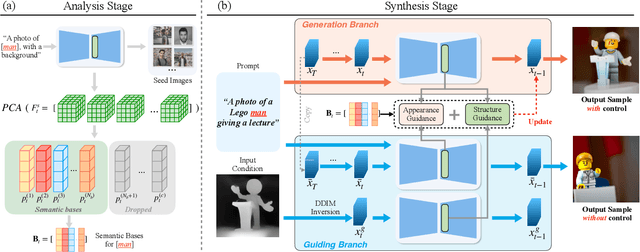
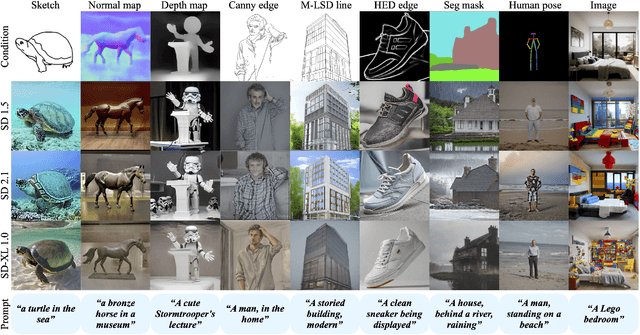
Abstract:Recent approaches such as ControlNet offer users fine-grained spatial control over text-to-image (T2I) diffusion models. However, auxiliary modules have to be trained for each type of spatial condition, model architecture, and checkpoint, putting them at odds with the diverse intents and preferences a human designer would like to convey to the AI models during the content creation process. In this work, we present FreeControl, a training-free approach for controllable T2I generation that supports multiple conditions, architectures, and checkpoints simultaneously. FreeControl designs structure guidance to facilitate the structure alignment with a guidance image, and appearance guidance to enable the appearance sharing between images generated using the same seed. Extensive qualitative and quantitative experiments demonstrate the superior performance of FreeControl across a variety of pre-trained T2I models. In particular, FreeControl facilitates convenient training-free control over many different architectures and checkpoints, allows the challenging input conditions on which most of the existing training-free methods fail, and achieves competitive synthesis quality with training-based approaches.
A Simple Transformer-Based Model for Ego4D Natural Language Queries Challenge
Nov 16, 2022Abstract:This report describes Badgers@UW-Madison, our submission to the Ego4D Natural Language Queries (NLQ) Challenge. Our solution inherits the point-based event representation from our prior work on temporal action localization, and develops a Transformer-based model for video grounding. Further, our solution integrates several strong video features including SlowFast, Omnivore and EgoVLP. Without bells and whistles, our submission based on a single model achieves 12.64% Mean R@1 and is ranked 2nd on the public leaderboard. Meanwhile, our method garners 28.45% (18.03%) R@5 at tIoU=0.3 (0.5), surpassing the top-ranked solution by up to 5.5 absolute percentage points.
Where a Strong Backbone Meets Strong Features -- ActionFormer for Ego4D Moment Queries Challenge
Nov 16, 2022

Abstract:This report describes our submission to the Ego4D Moment Queries Challenge 2022. Our submission builds on ActionFormer, the state-of-the-art backbone for temporal action localization, and a trio of strong video features from SlowFast, Omnivore and EgoVLP. Our solution is ranked 2nd on the public leaderboard with 21.76% average mAP on the test set, which is nearly three times higher than the official baseline. Further, we obtain 42.54% Recall@1x at tIoU=0.5 on the test set, outperforming the top-ranked solution by a significant margin of 1.41 absolute percentage points. Our code is available at https://github.com/happyharrycn/actionformer_release.
Physics to the Rescue: Deep Non-line-of-sight Reconstruction for High-speed Imaging
May 03, 2022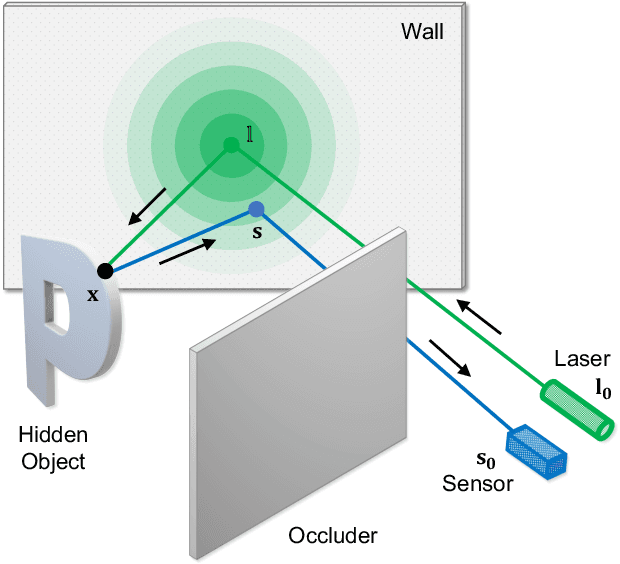

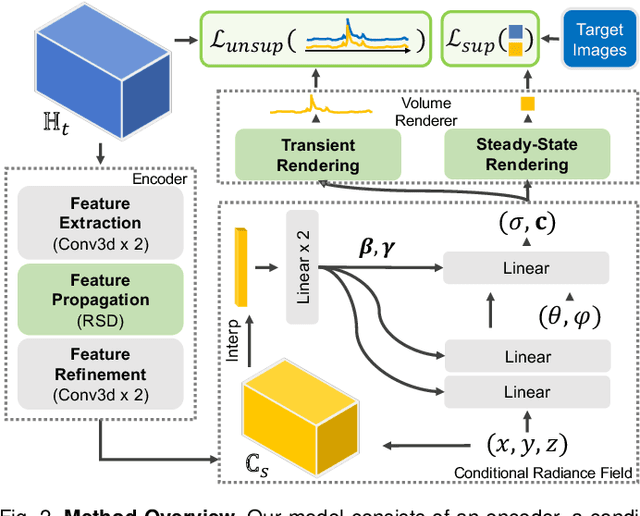
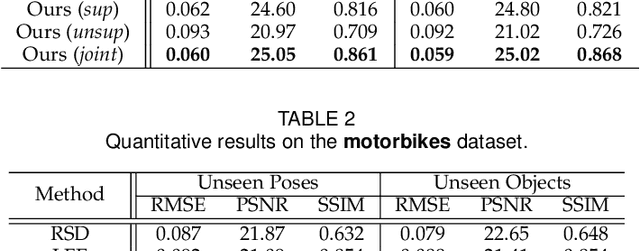
Abstract:Computational approach to imaging around the corner, or non-line-of-sight (NLOS) imaging, is becoming a reality thanks to major advances in imaging hardware and reconstruction algorithms. A recent development towards practical NLOS imaging, Nam et al. demonstrated a high-speed non-confocal imaging system that operates at 5Hz, 100x faster than the prior art. This enormous gain in acquisition rate, however, necessitates numerous approximations in light transport, breaking many existing NLOS reconstruction methods that assume an idealized image formation model. To bridge the gap, we present a novel deep model that incorporates the complementary physics priors of wave propagation and volume rendering into a neural network for high-quality and robust NLOS reconstruction. This orchestrated design regularizes the solution space by relaxing the image formation model, resulting in a deep model that generalizes well on real captures despite being exclusively trained on synthetic data. Further, we devise a unified learning framework that enables our model to be flexibly trained using diverse supervision signals, including target intensity images or even raw NLOS transient measurements. Once trained, our model renders both intensity and depth images at inference time in a single forward pass, capable of processing more than 5 captures per second on a high-end GPU. Through extensive qualitative and quantitative experiments, we show that our method outperforms prior physics and learning based approaches on both synthetic and real measurements. We anticipate that our method along with the fast capturing system will accelerate future development of NLOS imaging for real world applications that require high-speed imaging.
 Add to Chrome
Add to Chrome Add to Firefox
Add to Firefox Add to Edge
Add to Edge